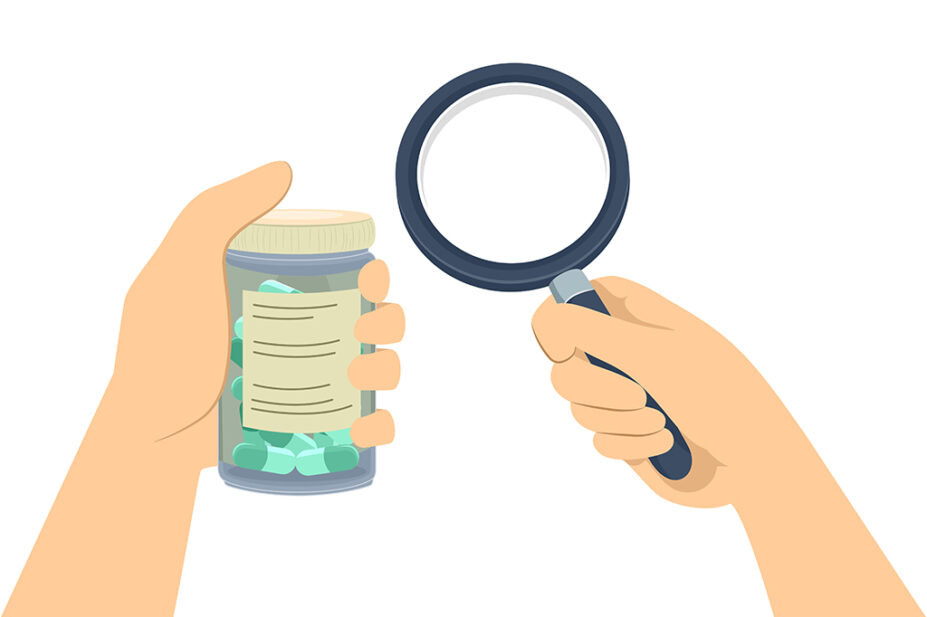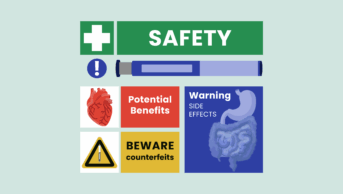
BNP Design Studio / Alamy Stock Photo
Over the past three years, pharmaceutical companies around the world have been quietly conducting one of the most significant medicines safety audits to ever be carried out[1].
The review into all human medicines on the market has been designed to seek out those that may contain, or have the potential to contain, certain chemicals linked with the development of cancer.
The chemicals they are looking for are ‘nitrosamines’, which are formed naturally in the environment and present in small, and safe, amounts in drinking water and food, including cured meats and dairy products. However, they can also form in some medicines during manufacturing, or even once the drug has been dispensed to the patient, and in quantities that are potentially carcinogenic.
In 2019, the European Medicines Agency (EMA) and other medicines regulators around the world asked marketing authorisation holders (MAHs) to carry out a comprehensive review of all chemical and biological human medicines for the possible presence of nitrosamines, with an initial risk evaluation due by 1 July 2021 and full confirmatory testing by 26 September 2022.
MAHs that found products containing nitrosamines above a certain level must submit marketing authorisation changes to their respective regulators later in 2023 (see Box).
The call from regulators came in the same year that the stomach acid-suppressing medicine ranitidine vanished from pharmacy shelves, after it was revealed that the drug could be contaminated with a potentially cancer-causing nitrosamine impurity called N-nitrosodimethylamine (NDMA).
The year before, in 2018, the same contaminant had been found in several blood pressure medicines, known as ‘sartans’, leading to recalls and a review by the EMA.
And, further reports of contamination have been made since then for several other drugs, including the diabetes drug metformin, first-line tuberculosis drug rifampicin and the smoking cessation medicine varenicline (Champix; Pfizer)[2].
“Guidance was put in place that said that every pharmaceutical has to be assessed for [nitrosamine contamination],” recalls Andrew Teasdale, senior principal scientist, impurity management, at AstraZeneca.
However, these assessments revealed that NDMA is not the only nitrosamine compound of concern — the issues with sartans and ranitidine were simply the tip of a much larger iceberg.
It’s an existential threat to many of our historic medicines, as well as the development of new medicines
Andrew Teasdale, senior principal scientist, impurity management, at AstraZeneca
“We went from a problem which was thought to be restricted to the chemistry [of the drug], to a problem that now impacts on major classes like beta blockers and [angiotensin-converting enzyme] inhibitors,” says Teasdale.
“It’s an existential threat to many of our historic medicines, as well as the development of new medicines.”
Interim figures from the audit, provided by the EMA to The Pharmaceutical Journal, reveal that 17% of centrally-authorised chemical products have been identified at being at risk of nitrosamine contamination.
The EMA said that the process of collecting data on all its products was continuing and that, of those that had a risk identified, so far only 15% contained nitrosamines levels above the “acceptable intake” and will likely require a variation in their marketing authorisation.
However, even a small percentage could relate to 20 or more products.
A spokesperson for the EMA said that, as part of the process, EU regulatory authorities were “carefully considering” the need to take regulatory action to protect public health while ensuring availability of critical medicines and considering the risk of shortages.
The Pharmaceutical Journal also approached the Medicines and Healthcare products Regulatory Agencies and, although it was unable to provide final numbers, it did confirm that the majority of companies who had completed the first two steps of the review had found there to be no risk.
How do nitrosamines form?
There are several ways in which nitrosamine impurities, such as NDMA, can form, both during manufacturing and in the drug product itself. However, what all of these have in common is a reaction between a secondary or tertiary amine and a nitrosating agent.
Initial concern over nitrosamines — for example, with the sartans class — were linked to the presence of trace secondary amines within the active pharmaceutical ingredient (API) manufacturing process, which were reacting with nitrosating agents linked to API manufacture, such as sodium nitrite[3].
Those kinds of things, especially when combined with humidity, can really degrade some of those products and can form nitrosamine issues
Michael White, professor of pharmacy practice at the University of Connecticut
“The problem wasn’t that there was something inherent in the manufacture of that product that was creating nitrosamines,” explains Michael White, professor of pharmacy practice at the University of Connecticut.
“What was happening was that when they were sending away their catalysts and solvents to get refurbished, they were intermingling those solvents with solvents from other manufacturers, from other industries [during the process].”
In the case of ranitidine, however, it was found that the API was being degraded to form NDMA once the medicine was on the shelf, or wherever a patient decided to store it.
“So, you get heartburn when you’re driving home and you’re on conference calls, so you keep your ranitidine inside the car so you can reach over and take one [when you need to],” quips White.
“But, during the day, it was 112 degrees in your car, the sun was beating down on the roof.
“Those kinds of things, especially when combined with humidity, can really degrade some of those products and can form nitrosamine issues.”
This discovery with ranitidine opened up the possibility that nitrosamine impurities could be formed from the drug itself, where the API itself is a secondary amine, or a closely related secondary amine impurity is present in the product, which can then react with nitrites present in the drug’s excipients[3]. These novel nitrosamines are referred to as nitrosamine drug substance-related impurities (NDSRIs).
A developing problem
There are currently more than 300 nitrosamines in existence and, of these, a growing number have been found in medicines.
In August 2022, the US Food and Drug Administration (FDA) announced that certain samples of sitagliptin, the active ingredient in several type 2 diabetes mellitus drugs manufactured by Merck Sharp & Dohme (MSD), were contaminated with the nitrosamine impurity, 7-Nitroso-3-(trifluoromethyl)-5,6,7,8-tetrahydro[1,2,4]triazolo-[4,3-a]pyrazine, or ‘NTTP’[4].
To avoid a shortage and help ensure patients continued to have access to an adequate supply of the medicine, the FDA said it would “not object” to the temporary distribution of sitagliptin containing NTTP above the acceptable intake limit of 37ng per day, and up to 246.7ng per day[5].
In early 2023, after an investigation, the MSD confirmed the root cause of nitrosamine contaminants in these drug products.
“Based on the results of our root cause investigation, it was confirmed that NTTP was formed during product manufacturing and, predominantly, during subsequent storage of the drug product,” a spokesperson told The Pharmaceutical Journal.
“In July 2022, we began testing of all batches of Januvia, Janumet, and Steglujan, before being released to any market, to ensure all batches meet the agreed-upon interim acceptable daily NTTP limit over the course of the product shelf life.”
We continue to work expeditiously on enhancing our controls to further minimise NTTP levels to meet the long-term acceptable daily intake level
Spokesperson for Merck Sharp & Dohme
According to the spokesperson, the company’s scientific and medical risk assessment found that there was a “negligible risk” to patient safety, including to patients who had taken these medicines for many years, from the current levels of NTTP.
“We continue to work expeditiously on enhancing our controls to further minimise NTTP levels to meet the long-term acceptable daily intake level,” they added.
These medicines are just the latest in what is likely to be a very long line of drugs contaminated with nitrosamines.
In the UK, precautionary recalls are already being actioned to avoid further exposure to impurity levels above the set limit.
In 2022, three medicines were recalled owing to the identification of nitrosamines above the acceptable limit, including Accuretic 10/12.5mg film-coated tablets (quinapril hydrochloride; Pfizer) and Accupro 5mg, 10mg, 20mg, 40mg film-coated tablets (quinapril hydrochloride; Pfizer), which were found to contain N-nitroso-quinapril, and Stemetil (prochlorperazine; Aventis Pharma Ltd [t/a Sanofi]) 5mg/5mL syrup, which was found to contain N-nitrosomethylphenylamine[6–8]. It is likely that further recalls will follow these over the next year.
The challenge regulators now have is how to set suitable parameters for nitrosamine levels; too high and it could lead to the withdrawal of a vast number of critical medicines, too low and the risk is that those taking these medicines will be consuming nitrosamines at a level that could be harmful to them.
Setting appropriate limits
There is no quick solution to this challenge.
In the meantime, the EMA, US FDA, and other regulatory agencies have set provisional acceptable daily intake limits for nitrosamines, which will help to control the presence of impurities that do not have sufficient toxicity data until a substance-specific ‘acceptable intake’ is established[9].
In the case of NDMA, the AI was set at 96ng/day. Assuming a maximum daily dose of 600mg for lifetime use (minimum of 10 years), this acceptable intake results in a limit of 0.16ppm in ranitidine-containing medicinal products.
Box: The great nitrosamine audit
Step one: Risk evaluation
To identify active substances and finished products at risk of nitrosamine formation or cross-contamination
Deadline: Chemical products: 31 March 2021; biological products: 1 July 2021
Step two: Risk assessment and confirmatory testing
Perform further confirmatory testing on the products identified to be at risk of nitrosamine formation or cross-contamination, and report confirmed presence of nitrosamines and whether it exceeds the lifetime excess cancer risk of 1:100,000.
Deadline: Chemical products: 26 September 2022; biological products: 1 July 2023
Step three: Changes to the marketing authorisation
Marketing authorisation holders apply for any necessary changes to the manufacturing process resulting from this review.
Deadline: Chemical products: 1 October 2023; biological products: 1 July 2023[10]
Currently, there are little data on the carcinogenic potency of nitrosamines in humans, and so the potential risk for humans has been extrapolated from animal — largely rodent — data[11].
However, not all nitrosamines are the same — the more novel and structurally complex NDSRIs are not likely to have the same carcinogenic potency as simple nitrosamines, but more data are needed[11].
Health authorities are requesting more supporting safety science evidence to confirm the risk of NDSRIs, which companies are currently compiling, but this will take a significant amount of time.
“We know that chemistry-related nitrosamines are carcinogens. These drug-like nitrosamines that are forming from the drug itself, like nitroso-propanolol … are much larger, more complex molecules,” says Teasdale.
“The industry view is that they’re not as potent carcinogens as the small ones, the regulator view is quite different — it’s much more precautionary.”
He adds that “an attempt” has been made by the regulators to apply the same limits to these new nitrosamines as with the likes of the simpler NDMA, something he says “cannot be practically applied” without withdrawing vast quantities of medicines from the market.
All action is being taken to introduce controls on nitrosamine impurities where necessary, while securing supply of essential medicines where possible
A spokesperson for the European Federation of Pharmaceutical Industries and Associations
“We have to look more carefully at the safety limits and set more appropriate safety limits that will mean we have a viable supply chain,” he adds.
Other issues also exist when it comes to testing for these impurities. The bacterial reverse mutation assay, or Ames test, is the first step in determining the potential carcinogenicity of a compound and is well recognised around the world.
However, at the beginning of 2022, authorities raised concern over the validity of Ames results for nitrosamines; the optimal conditions for detecting mutagenic nitrosamines in the Ames test have not yet been fully determined and the mutagenic potencies of nitrosamines can differ significantly and do not correlate to similar carcinogenic potency[3,12]. Revisions to the test may be required, which could take some time.
Research suggests that it may be possible to eliminate nitrites from excipients or inhibit nitrosamine formation in drug products altogether, but this work is still in the early stages[13].
Although the figures from the EMA suggest a relatively small number of drugs will be affected, some research indicates that the presence of nitrosamines in pharmaceuticals is likely to be more prevalent than originally expected. In one analysis of more than 12,000 small molecule drugs and drug impurities, 40.4% of API analysis and 29.6% of API impurities were identified as potential nitrosamine precursors[14].
As many of the NDSRIs are novel and structurally complex, understanding of how they form, and can therefore be controlled, will continue to evolve. In the meantime there is a very real risk that supplies of medicines will be impacted.
As the final October 2023 deadline for MAHs to submit their variations to marketing authorisations fast approaches, it is clear that there is a fine balance to be struck between public health and public safety.
“Industry and regulators have been addressing the risks posed by nitrosamine impurities in medicines since this was identified as a public health concern in 2019,” said a spokesperson for the European Federation of Pharmaceutical Industries and Associations.
“Investigations so far have confirmed that the great majority of products are free from nitrosamine impurities, but companies continue to work closely with regulators to do further testing and compile more scientific evidence in this area.
“We have confidence in the robust international regulatory process underway. All action is being taken to introduce controls on nitrosamine impurities where necessary, while securing supply of essential medicines where possible.”
And for those who rely on a regular supply of these medicines, that last point will be crucial.
- 1EMA advises companies on steps to take to avoid nitrosamines in human medicines. European Medicines Agency. 2019.https://www.ema.europa.eu/en/documents/referral/nitrosamine-impurities-interim-outcome-article-53_en.pdf (accessed 13 Apr 2023).
- 2Ruepp R, Frötschl R, Bream R, et al. The EU Response to the Presence of Nitrosamine Impurities in Medicines. Front. Med. 2021;8. doi:10.3389/fmed.2021.782536
- 3Teasdale A, Hughes K. Regulatory Highlights. Org. Process Res. Dev. 2023;27:394–8. doi:10.1021/acs.oprd.3c00055
- 4Extance A. Merck & Co identifies nitrosamine source in diabetes drugs. Chemistry World. 2023.https://www.chemistryworld.com/news/merck-and-co-identifies-nitrosamine-source-in-diabetes-drugs/4016921.article?adredir=1 (accessed 13 Apr 2023).
- 5FDA works to avoid shortage of sitagliptin following detection of nitrosamine impurity. US Food and Drug Administration. 2022.https://www.fda.gov/drugs/drug-safety-and-availability/fda-works-avoid-shortage-sitagliptin-following-detection-nitrosamine-impurity (accessed 13 Apr 2023).
- 6Class 2 Medicines Recall: Pfizer Limited, Accuretic 10/12.5 mg film-coated tablets, EL (22)A/16. GOV.UK. 2022.https://www.gov.uk/drug-device-alerts/class-2-medicines-recall-pfizer-limited-accuretic-10-slash-12-dot-5-mg-film-coated-tablets-el-22-a-slash-16 (accessed 13 Apr 2023).
- 7Class 2 Medicines Recall: Pfizer Limited, Accupro 5mg, 10mg, 20mg, 40mg film-coated tablets, EL(22)A/21. GOV.UK. 2022.https://www.gov.uk/drug-device-alerts/class-2-medicines-recall-pfizer-limited-accupro-5mg-10mg-20mg-40mg-film-coated-tablets-el-22-a-slash-21 (accessed 13 Apr 2023).
- 8Class 2 Medicines Recall: Aventis Pharma Limited (t/a Sanofi), Stemetil 5mg/5ml Syrup, EL(22)A/41. GOV.UK. 2022.https://www.gov.uk/drug-device-alerts/class-2-medicines-recall-aventis-pharma-limited-t-slash-a-sanofi-stemetil-5mg-slash-5ml-syrup-el-22-a-slash-41 (accessed 13 Apr 2023).
- 9Questions and answers for marketing authorisation holders/applicants on the CHMP Opinion for the Article 5(3) of Regulation (EC) No 726/2004 referral on nitrosamine impurities in human medicinal products. European Medicines Agency. 2023.https://www.ema.europa.eu/en/documents/referral/nitrosamines-emea-h-a53-1490-questions-answers-marketing-authorisation-holders/applicants-chmp-opinion-article-53-regulation-ec-no-726/2004-referral-nitrosamine-impurities-human-medicinal-products_en.pdf (accessed 13 Apr 2023).
- 10Medicines: Marketing Authorisation Holders’ submission of Nitrosamine risk evaluation, risk assessment and confirmatory testing. GOV.UK. 2019.https://www.gov.uk/guidance/medicines-marketing-authorisation-holders-submission-of-nitrosamine-risk-evaluation (accessed 13 Apr 2023).
- 11Cross KP, Ponting DJ. Developing structure-activity relationships for N-nitrosamine activity. Computational Toxicology. 2021;20:100186. doi:10.1016/j.comtox.2021.100186
- 12Nanda KK, Tignor S, Clancy J, et al. Inhibition of N-Nitrosamine Formation in Drug Products: A Model Study. Journal of Pharmaceutical Sciences. 2021;110:3773–5. doi:10.1016/j.xphs.2021.08.010
- 13Nitrosamines as Impurities in Drugs— Health Risk Assessment and Mitigation Public Workshop. US Food and Drug Administration. 2021.https://www.fda.gov/media/150932/download#:~:text=Testing%20for%20mutagenicity%20by%20Ames,correlate%20to%20similar%20carcinogenic%20potency (accessed 13 Apr 2023).
- 14Schlingemann J, Burns MJ, Ponting DJ, et al. The Landscape of Potential Small and Drug Substance Related Nitrosamines in Pharmaceuticals. Journal of Pharmaceutical Sciences. 2022. doi:10.1016/j.xphs.2022.11.013
1 comment
You must be logged in to post a comment.



Has any agency or research looked at the presence of nitrosamines in "food or health supplements"? Significant numbers of the public consume these too.